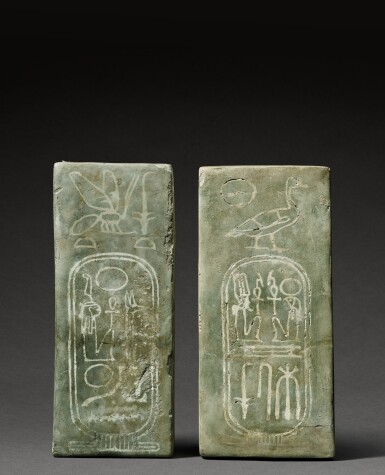Ancient Sculpture and Works of Art Part I
Ancient Sculpture and Works of Art Part I

Property from an English Private Collection
Two Large Egyptian Turquoise Faience Foundation Tiles, 19th Dynasty, period of Ramesses II, 1279-1212 B.C.
Auction Closed
December 7, 04:32 PM GMT
Estimate
30,000 - 50,000 GBP
Lot Details
Description
Property from an English Private Collection
Two Large Egyptian Turquoise Faience Foundation Tiles
19th Dynasty, period of Ramesses II, 1279-1212 B.C.
each of rectangular form inlaid in white with an inscribed cartouche, the first cartouche containing the prenomen of King Ramesses II, "Usermaatre Setepenre," surmounted by the title "King of Upper and Lower Egypt," the second containing the king’s nomen, "Ra’-masesu meri Amon."
37 by 17 by 7 cm.
Matthias Komor (1909-1984), New York, inv. nos. E 529 (left) and E 530 (right)
Clarence Day (1927-2009), Memphis, Tennessee, acquired from the above in 1975
private collection, Japan
Sotheby’s, New York, June 7th, 2005, no. 83, illus.
property of a private foundation
acquired from the above by the present owner
For related examples of similar size cf. W. C. Hayes, Glazed Tiles from a Palace of Ramesses II at Kantir, New York, 1937, pl. I, Staatliche Sammlung ägyptischer Kunst, Munich, 1976, pp. 118-119, no. ÄS 5535, and Sotheby's, New York, June 12th, 2003, no. 86. For smaller, mostly painted examples see Meisterwerke altägyptischer Keramik, p. 175, no. 287, and André Wiese, Antikenmuseum Basel und Sammlung Ludwig. Die ägyptische Abteilung, Mainz am Rhein, p. 134, no. 92.
